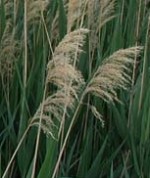 Native to temperate wetlands world wide, this perennial aquatic grass is a member of the grass family, Poaceae, that also includes corn, rice, and bamboo. It is a vigorous grower and can form extensive stands in damp ground, standing in water 3′ deep, or as a floating mat. With thick, long, unbranched rhizomes, common reed grows up to twenty feet tall and has a leafy, hollow, unbranched stem. The broad, flat leaf blades are green to grayish green, deciduous, seven to twenty four inches long, and have rough margins. The purplish flowers are carried in large feathery highly branched panicles six to twenty inches long from mid-summer to fall. As the panicles mature they develop long, silky hairs and appear gray. Photo Credit Wikipedia
Native to temperate wetlands world wide, this perennial aquatic grass is a member of the grass family, Poaceae, that also includes corn, rice, and bamboo. It is a vigorous grower and can form extensive stands in damp ground, standing in water 3′ deep, or as a floating mat. With thick, long, unbranched rhizomes, common reed grows up to twenty feet tall and has a leafy, hollow, unbranched stem. The broad, flat leaf blades are green to grayish green, deciduous, seven to twenty four inches long, and have rough margins. The purplish flowers are carried in large feathery highly branched panicles six to twenty inches long from mid-summer to fall. As the panicles mature they develop long, silky hairs and appear gray. Photo Credit Wikipedia
Four different kinds of reeds are mentioned in the Bible but there is considerable disagreement on the identification of the plants. Although common reed may be the plant intended in the passages below, good alternatives include Arundo donax and Sorghum vulgare.
Genesis 41:2 (NIV) The Pharaoh’s had a dream:
“when out of the river there came up seven cows, sleek and fat, and they grazed among the reeds.”
Isaiah 9:14 (NIV) The prophet predicts that God will overthrow the leadership because the people will not repent.
“So the LORD will cut off from Israel both head and tail, both palm branch and reed in a single day;”
Isaiah 58:5 (NIV) God rebukes the people for their empty show of fasting.
“Is this the kind of fast I have chosen, only a day for people to humble themselves? Is it only for bowing one’s head like a reed and for lying in sackcloth and ashes? Is that what you call a fast, a day acceptable to the LORD?”
III Maccabees 4:20 (CEB) Pharaoh Ptolemy IV Philopater attempts to register the Jews for execution but learns that their shear number makes it impossible.
“when they [Ptolemy’s clerks] explained and offered proof that both the paper supply and the reed pens that they were using had already run out.”
III John 1.13 (NIV) In his letter to Gaius, John explains that the letter is short because he prefers to see Gaius face to face.
“I have much to write you, but I do not want to do so with pen and ink.”
Common reed likes full sun to partial shade, and average, wet to damp soil in USDA Hardiness Zones 4-8 but tolerate alkaline and saline conditions. Propagation is by division. Plants are susceptible to damage by insects, viruses, and bacteria. Because of their vigorous rapid growth plants may become invasive but can be controlled in grasslands by regular grazing of livestock. In addition, common reed may become invasive in marshes and estuaries. Although considered weedy and invasive, the plant is/has been used for many purposes including food, fodder, medicine, thatch, weaving material, pen, paper, and dried flower arrangements.
The genus name, Phragmites, comes from the Greek word phragma meaning hedge and refers to its growth habit. The specific epithet, australis, is from the Latin word auster meaning south wind i.e. the southern country.